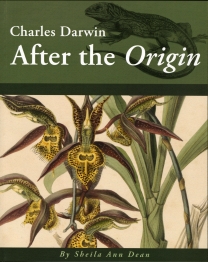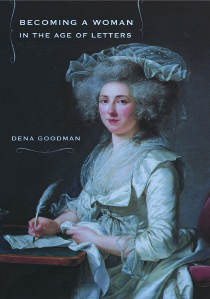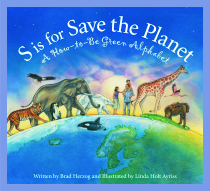CORNELL BOOKS
After the 'Origin' ... CU's first black students ... lives through letters ... an Ithaca landscape ... greening the alphabet
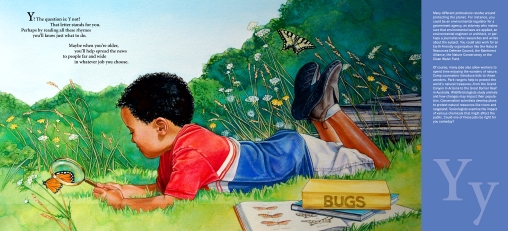
A page from "S Is for Save the Planet: A How-to-Be-Green Alphabet"
Exploring Darwin's life after the 'Origin'
What did Charles Darwin do during the 22 years after "On the Origin of Species" was published?
A new book by Darwin scholar Sheila Ann Dean answers that question and many others about the work Darwin undertook while controversies instigated by the "Origin" stirred the Victorian world. The book is "Charles Darwin: After the 'Origin'" (Cornell University Library [CUL] and Paleontological Research Institution [PRI], 2009).
Published to coincide with the 200th anniversary of Darwin's birth and the international Darwin Day celebration, both held earlier this year, the book also served as a companion piece to the collaborative 2009 exhibition at CUL and the Museum of the Earth at PRI. Dean is a guest curator and visiting scholar at Cornell; the book was made possible by a gift from Stephan Loewentheil, J.D. '75.
"In this thoughtful and insightful review, Sheila Ann Dean has illuminated the most productive years of Darwin's life," says David Corson, curator of the History of Science Collections at CUL.
Dean's book explores how, from 1859 until his death in 1882, Darwin worked tirelessly to provide further support for his ideas presented in the "Origin." He continued his original investigations into botanical topics, inheritance in domesticated animals and plants, sexual selection, human descent, animal expression and the movement of soil by earthworms.
"After the 'Origin' was published, Darwin applied his ideas to a surprisingly wide range of plant and animal life, and scientists have continued to enlarge and refine evolutionary biology over the last 150 years," Dean says. "This account of Darwin's later work can inform today's debates on the teaching of evolution."
Cornell's first African-American students
In Cornell's first 80 years, more than 200 African-American students took classes on the hill. But anyone seeking to explore the world of Cornell's first black students runs into a roadblock: The university was officially color blind. In "Part & Apart: The Black Experience at Cornell, 1865-1945" (CUL, 2009), historian and retired Cornell lecturer Carol Kammen takes up the challenge. Scouring primary sources -- yearbook entries, students' diaries, administrators' correspondence, local and national newspapers -- she identifies black students enrolled at Cornell for both undergraduate and graduate study.
Thanks to her research, we now know many of their names and can see some photographs, but we also learn something of their lives while they attended Cornell: how they interacted with white students, what special obstacles they faced and surmounted, how they maintained their identity in a small, predominantly white city in rural New York and what they thought about their place in the university and in society. Kammen places her findings in the context of post-Civil War America and the political and social changes of the decades that followed.
For the book, Kammen made use of the extensive archival materials at CUL, including letters, diaries, student records, newspapers and photographs.
The Tompkins County historian, Kammen was named the 2005-06 Public Historian of the Year. Of her many previous books, two are about Cornell: "Glorious to View: A History of Cornell" and "First-Person Cornell: Students' Diaries, Letters, Email and Blogs."
How they lived through letters
Over the course of the 18th century in France, increasing numbers of women, from the wives and daughters of artisans and merchants to countesses and queens, wrote letters.
Taking as her inspiration a portrait of an unknown woman writing a letter to her children by French painter Adélaïde Labille-Guiard, Dena Goodman '74 (now professor of history and women's studies at the University of Michigan) challenges the deep-seated association of women with love letters and proposes a counternarrative -- that of young women struggling with the challenges of the modern world through the mediation of writing. In "Becoming a Woman in the Age of Letters" (Cornell University Press, 2009), Goodman enters the lives and worlds of these women, drawing on their letters, the cultural history of language and education, and the material culture of letter writing itself -- inkstands, desks and writing paper.
Goodman follows the lives of elite women from childhood through their education in traditional convents and modern private schools and into the shops and interior spaces in which furnishings and furniture were made for, sold to and used by women who took pen in hand. Stationers set up fashionable shops, merchants developed lines of small writing desks, and the furnishings and floor plans of homes changed to accommodate women's needs. It was as writers and consumers that women entered not only shops but also the modern world that was taking shape in Paris and other cities.
Sights and sites of Cornell -- and Ithaca
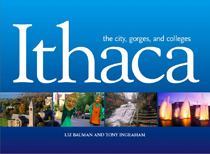
"Ithaca -- the city, gorges and colleges" (Owl Gorge Productions, 2009) paints a portrait of Ithaca's special character with more than 200 color photographs and engaging chapter introductions and captions. Several of the photos included are by photographers from Cornell University Photography.
The city chapter kicks off the book with the Ithaca Festival, downtown and Stewart Park. The chapter "Gorges, Waterfalls and Cayuga Lake" showcases Buttermilk, Treman and Taughannock Falls state parks. The 26-page Cornell chapter presents campus scenes interspersed with photos of Dragon Day, the men's ice hockey team and rowers on Cayuga Inlet.
"Nearby Ithaca" pops with images of the GrassRoots Festival, stunning farm scenes and the Museum of the Earth. "Historical Highlights" are displayed through documents, maps, old photos and postcards.
Liz Bauman '73 (and a Cornell editor from 1977 to 2008) collaborated with Tony Ingraham '69, former director of environmental education for the Finger Lakes State Parks, to produce the book. Linda Haylor Mikula, associate director for public affairs in the Division of University Communications, designed the book. It is available at the Cornell Store, the Cornell Club in New York and online through the Cornell Store.
Alphabet book goes green
Did you know that Americans generate nearly 250 million tons of trash each year? Or that it takes hundreds of years for a polystyrene cup to decompose? Our negative impact on the planet is tremendous, and the challenge of protecting it can seem overwhelming. In "S Is for Save the Planet: A How-to-Be-Green Alphabet" (Sleeping Bear Press, 2009) by Brad Herzog '90, the many environmental issues we face are described, and simple actions are suggested. From the particulars of vermicomposting and xeriscaping to the three R's of responsible waste management, young readers learn how they can be a force of nature in protecting the Earth.
Herzog has penned more than a half dozen children's books in his alphabet series, from "A Is for Amazing Moments" to "R Is for Race." He also is the author of a series of travel memoirs ("States of Mind," "Small World: A Microcosmic Journey" and the upcoming "Greek to Me: A Would-Be Hero's American Odyssey").
